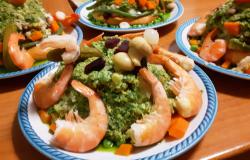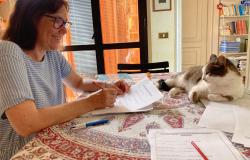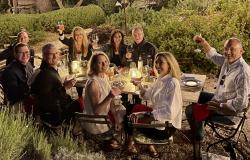Words and Images by Catherine Richards Golini
Sanremo lies in a sheltered inlet between Capo Verde and Capo Nero on the rocky Ligurian coast, a city synonymous with fun, glitz and the sun. Flowers, a festival and a flutter attract a good many visitors, as do the comfortable year-round temperatures and the sandy beaches, though San Remo also has an extensive and fascinating città vecchia, known as La Pigna, a warren of silent, twisting alleys and cobbled piazzas.
Smollett wrote favourably of both the town and its women: ‘...the hills are covered with oranges, lemons, pomegranates and olives, which produce a considerable traffic in fine fruits and excellent oil. The women of St. Remo are much more handsome and better tempered than those of the Provence.’
Read the full guide or directly jump to:
1. Sanremo famous visitors
2. City's events
3. City Attractions
4. Further Information: how to get there, where to stay, where to eat.
Peaceful invasions
 Once the Genova-Ventimiglia railway line was completed in 1872, with its spanking new station right on the sea front, hotels sprang up to accommodate the Russians, the British and the Germans who’d heard good things about San Remo – not least that it was cheaper than nearby Nice.
Once the Genova-Ventimiglia railway line was completed in 1872, with its spanking new station right on the sea front, hotels sprang up to accommodate the Russians, the British and the Germans who’d heard good things about San Remo – not least that it was cheaper than nearby Nice.
The illustrator and writer Edward Lear, who lived and died here (he’s buried in the Foce cemetery), was infuriated to learn, in 1874, that his splendid sea view was going to be blocked by one such hotel, destined to be ‘the very largest in San Remo’.
 In 1874 Tsarina Maria Aleksandrovna donated the palm trees along the prom and in return a grateful town council named ‘Corso Imperatrice’ for her. Other Russians, wealthy but unhealthy, followed the Tsarina’s example. As the size of the Russian community grew, plans were mooted for an orthodox church, which was finally finished in 1912. Beautifully decorated and still in use, its façade shimmers with turquoise, rose and gold.
In 1874 Tsarina Maria Aleksandrovna donated the palm trees along the prom and in return a grateful town council named ‘Corso Imperatrice’ for her. Other Russians, wealthy but unhealthy, followed the Tsarina’s example. As the size of the Russian community grew, plans were mooted for an orthodox church, which was finally finished in 1912. Beautifully decorated and still in use, its façade shimmers with turquoise, rose and gold.
Reminders of San Remo’s heyday are everywhere: streets are named for the more illustrious of the visitors; the grand hotels that hosted them still stand (some a little faded), while Corso degli Inglesi, which twists and turns for two kilometres along the sea front, is lined with the villas and gardens of those who loved it all so much they couldn’t bear to leave.
Between 1874 and 1906, as many as 25 hotels and nearly 200 villas were built, with the majority still standing today.
Sanremo - the city of the Italian music...
 The chic and the well-heeled still flock to San Remo. They shop on Corso Matteotti, moor their yachts in the marina or have a flutter at the casino.
The chic and the well-heeled still flock to San Remo. They shop on Corso Matteotti, moor their yachts in the marina or have a flutter at the casino.
Built in 1905 by French architect Eugenio Ferret, it’s one of only four casinos in the entire country and it was here, in 1951, that the first San Remo Music Festival took place, an event so popular in Italy today that it’s known as Il Festival – the festival. The organisers have a lot to answer for: the Eurovision Song Contest was directly inspired by San Remo, which outgrew the casino and is now held in the Ariston Theatre.
The most important event in the calendar, the city fills with fans, the media and a host of homegrown and international stars and unless you’re particularly fond of Italian popular music, you’d be advised to give San Remo a wide berth in the last week of February.
... and flowers
 As well as music, San Remo is synonymous with floriculture. The rocky hills that sit behind and around the town are awash with enormous glasshouses – this is an industry employing 27,000 and with annual sales of 600 million euro. To celebrate the importance of flowers to San Remo, the city hosts a January Flower Festival and Parade, where floats decorated with thousands of brightly coloured blooms weave their way through the town. From early March, older Europeans arrive in search of spring and, come the summer, San Remo is the resort of choice for thousands of holidaying Italians. In common with most of the country, the beaches get very, very busy, particularly in July and August. Visitors with a car might prefer to head further east along the coast for wider, less crowded sands.
As well as music, San Remo is synonymous with floriculture. The rocky hills that sit behind and around the town are awash with enormous glasshouses – this is an industry employing 27,000 and with annual sales of 600 million euro. To celebrate the importance of flowers to San Remo, the city hosts a January Flower Festival and Parade, where floats decorated with thousands of brightly coloured blooms weave their way through the town. From early March, older Europeans arrive in search of spring and, come the summer, San Remo is the resort of choice for thousands of holidaying Italians. In common with most of the country, the beaches get very, very busy, particularly in July and August. Visitors with a car might prefer to head further east along the coast for wider, less crowded sands.
City Attractions
 Shade and solitude, no matter what the season, can be found in La Pigna, the city’s oldest and most fascinating district. Named for its resemblance to a pine cone, La Pigna dates from 1000 AD and is built in concentric circles that spread upwards across the hill, with twisting, stepped alleys that let in little of the famous sunshine. ‘To get to the bottom of the alley, sun rays have to plunge downward close to cold walls,’ wrote Italo Calvino, who grew up in San Remo. ‘These walls are kept apart by arches which cut through the deep sky. Sun rays plunge straight downward, along windows scattered randomly in the walls, along basil and oregano plants that flourish inside pots placed on window sills, along the underwear hanging on the ropes.’
Shade and solitude, no matter what the season, can be found in La Pigna, the city’s oldest and most fascinating district. Named for its resemblance to a pine cone, La Pigna dates from 1000 AD and is built in concentric circles that spread upwards across the hill, with twisting, stepped alleys that let in little of the famous sunshine. ‘To get to the bottom of the alley, sun rays have to plunge downward close to cold walls,’ wrote Italo Calvino, who grew up in San Remo. ‘These walls are kept apart by arches which cut through the deep sky. Sun rays plunge straight downward, along windows scattered randomly in the walls, along basil and oregano plants that flourish inside pots placed on window sills, along the underwear hanging on the ropes.’
The silence that pervades La Pigna is broken, occasionally, by the murmuring of residents’ TV sets and the chirping of caged canaries. You can wander for an hour here and yet see only a handful of people: two giggling, teenage girls walk arm-in-arm; an elderly man sits reading in the street; a young man with shopping bags rushes up the hill and then, in a flash, is gone.
 One way to reach La Pigna is through the 14th-century gate of Porta di Santo Stefano, one of only two surviving medieval gates in the city. From here it’s a short walk along Rivolte San Sebastiano to the elegant Piazza del’Oratorio dei Dolori. The oratory has some fine 18th-century frescoes, though it’s the inscription from 1642 at the colonnaded entrance that might prove more memorable: ‘It is forbidden to urinate or leave filth under this vault under penalty of four lire,’ it warns. Snitches are assured their identities won’t be divulged.
One way to reach La Pigna is through the 14th-century gate of Porta di Santo Stefano, one of only two surviving medieval gates in the city. From here it’s a short walk along Rivolte San Sebastiano to the elegant Piazza del’Oratorio dei Dolori. The oratory has some fine 18th-century frescoes, though it’s the inscription from 1642 at the colonnaded entrance that might prove more memorable: ‘It is forbidden to urinate or leave filth under this vault under penalty of four lire,’ it warns. Snitches are assured their identities won’t be divulged.
 Though today La Pigna is home to the less-well-off in San Remo, it wasn’t always so. On via Monta, a sign marks the home of Count Sapia Rossi, a La Pigna noble who hosted Napoleon Bonaparte in 1784. In via Palma, once the principal artery of the district, you can still see the decorated portal of Palazzo Manara, dubbed ‘the best home in San Remo’ in 1538. A fusion of a number of medieval buildings, the palazzo was considered impressive enough to host Pope Paul III in the same year, en route to Nice to uphold peace between the warring Charles V and Francis I.
Though today La Pigna is home to the less-well-off in San Remo, it wasn’t always so. On via Monta, a sign marks the home of Count Sapia Rossi, a La Pigna noble who hosted Napoleon Bonaparte in 1784. In via Palma, once the principal artery of the district, you can still see the decorated portal of Palazzo Manara, dubbed ‘the best home in San Remo’ in 1538. A fusion of a number of medieval buildings, the palazzo was considered impressive enough to host Pope Paul III in the same year, en route to Nice to uphold peace between the warring Charles V and Francis I.
 A steepish climb to the top of via Palma, and the visitor finds the 17th-century sanctuary of the Madonna della Costa, built on the site of a 14th-century church and one of the city’s most loved monuments. The dome dates from the 18th century. The Baroque reconstruction was paid for in part by a generous donation of gold from a San Remo sailor, in gratitude to the Madonna for his having survived a shipwreck.
A steepish climb to the top of via Palma, and the visitor finds the 17th-century sanctuary of the Madonna della Costa, built on the site of a 14th-century church and one of the city’s most loved monuments. The dome dates from the 18th century. The Baroque reconstruction was paid for in part by a generous donation of gold from a San Remo sailor, in gratitude to the Madonna for his having survived a shipwreck.
 The 12th-century Cathedral of San Siro is the city’s most impressive religious structure, a few moments south of the tower. Though the Genovese destroyed the original belltower in the 18th century and various restoration projects make for a mix of styles, the interior contains some interesting sculpture, painting and an immense wooden crucifix by Anton Maria Maragliano, a Genovese sculptor born in 1664.
The 12th-century Cathedral of San Siro is the city’s most impressive religious structure, a few moments south of the tower. Though the Genovese destroyed the original belltower in the 18th century and various restoration projects make for a mix of styles, the interior contains some interesting sculpture, painting and an immense wooden crucifix by Anton Maria Maragliano, a Genovese sculptor born in 1664.
Further information
How to get to Sanremo
Fly to either Nice (50km) or Genova (140km). From Nice, journey time is approximately 40 mins by car or 1hr 15 mins by train. From Genova, journey time is approximately 80 mins by car or 2 hours by train.
Where to stay
 Royal Hotel - Inaugurated in 1872, the Royal Hotel Sanremo is an exclusive 5-star hotel rich in history and tradition, just the ideal choice for guests seeking intimacy, relaxation and luxury: a perfect blend of refinement, modern comfort, warm hospitality and personalised service.
Royal Hotel - Inaugurated in 1872, the Royal Hotel Sanremo is an exclusive 5-star hotel rich in history and tradition, just the ideal choice for guests seeking intimacy, relaxation and luxury: a perfect blend of refinement, modern comfort, warm hospitality and personalised service.
Unique location on the charming Italian “Riviera of Flowers”, just one hour from Nice Intl Airport and 45 minutes from Monte-Carlo, with stunning views over the Mediterranean sea.
Where to eat
A Cuvea, Corso Garibaldi 10, tel. (+39) 0184 503498 (+39) 0184 503498 A simple trattoria serving Ligurian specialities at very good prices.
(+39) 0184 503498 A simple trattoria serving Ligurian specialities at very good prices.
Paola e Barbara, Via Roma 47, tel. (+39) 0184 531653 (+39) 0184 531653; Michelin-starred restaurant run by husband and wife team. An experience to remember.
(+39) 0184 531653; Michelin-starred restaurant run by husband and wife team. An experience to remember.




